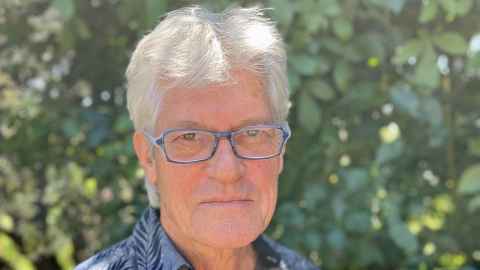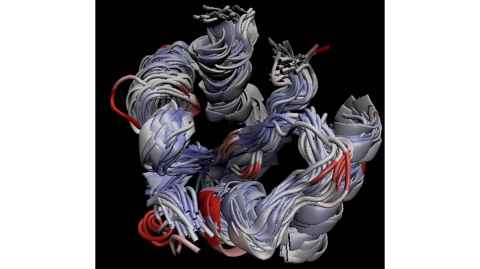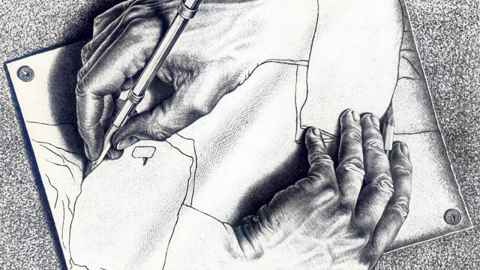How did life on Earth begin? This scientist will test a novel theory
4 April 2022
Biophysicist Dr Peter Wills and colleagues have $2 million to test a theory on the origins of all life.

Nearly four billion years ago, Earth was wildly volcanic with an orange sky, green seas, and meteorites crashing down with frequency. How did life emerge in this forbidding environment?
Back in 1871, Charles Darwin imagined a “warm little pond” of chemicals as the starting point, or what became known as a “primordial soup.”
Over the next 150 years, breakthroughs in genetics allowed scientists to develop more detailed theories.
The most widely-accepted theory, called “RNA world,” is that molecules of RNA – DNA’s lesser-known cousin, now slightly better known because of mRNA Covid-19 vaccines – self-replicated in the soup, kick-starting life on earth. More of the building blocks of life such as proteins and DNA came later.
Dr Peter Wills, of the Faculty of Science at the University of Auckland, doesn’t buy it.
He and collaborator Professor Charlie Carter, an origin-of-life scientist from the University of North Carolina-Chapel Hill in the US, have already spent years pursuing their alternative theory.

The pair believe that RNA was likely unable to replicate itself, and a better bet is that RNA and peptides – chains of amino acids that are essentially smaller and simpler versions of proteins – evolved together to create the first genetic code.
Strong evidence for this theory would rewrite the textbooks.
This month, Dr Wills, Professor Carter and collaborators including Dr Remco Bouckaert, of the University of Auckland’s School of Computer Science, and Drs Mark Ditzler and Milena Popovic, scientists at space agency NASA in the US, begin a US$1.5 million ($2.2 million) project to pursue the theory via bioinformatic research and experiments. (NASA’s research interests include how life emerged on earth and could emerge elsewhere.)
A US not-for-profit, the Alfred P. Sloan Foundation awarded the money in February as part of its “Matter-to-Life” program encouraging research into how life emerges from matter.
“Within three years we should be able to firmly establish the plausibility of our hypothesis in relation to the origin of genetic coding,” says Dr Wills, who retired from the University in 2021 but continues his work thanks to the Sloan grant.
But don’t expect proof.
“Empirically proving the origin of genetic coding may be as impossible as proving the physical origin of the cosmos,” says Dr Wills.

The scientists’ theory that RNA and peptides evolved together is based in part on the “structural complementarity” between the two. In other words, RNA and peptides fit so well together that it seems unlikely they evolved independently. Dr Wills and Professor Carter now aim to work out how the duo may have become self-replicating.
To test their theories about coding, the scientists reach back in time to reconstruct ancestral versions of enzymes called aminoacyl-tRNA synthetases (aaRS), then observe how these primitive proteins behave in the lab. The idea is that a pair of these may have been the first, primitive genetic coders.
“We create molecules that we think are four-billion-year-old ancestors of our own enzymes and investigate whether they perform their coding tasks, even if they are a lot slower than modern, evolved enzymes,” says Dr Wills.
The molecules are measured on the scale of the nanometre, a billionth of a metre.
Dr Wills undertakes computational and modelling tasks, such as building the family trees of enzymes to reconstruct their ancestral versions, guessing the most probable parent sequences of modern genes. Professor Carter conducts experiments in the lab, chemically creating the “ancestral” molecules and testing how they behave.

Two distinct classes of aaRS coding enzymes are still found in all organisms – from bacteria to fungi to mammals – even after four billion years of evolution.
“These are the yin-yang relics of the first enzymes that used coding to cooperatively maintain their different structures and functions,” says Wills. “This is where I tend to wax lyrical and lose everyone in the confusion of biology’s circular logic!”
For Dr Wills, a fascination with genetic coding dates back to 1977 when as a 25-year-old PhD student he attended a conference in Germany in honour of the Nobel Prize-winning chemist Manfred Eigen, who approached evolution at the molecular level and investigated the “self organisation of matter.” (Dr Wills later worked in Eigen’s lab.)

Forty years later, in 2017, Dr Wills and Professor Carter published papers in the journals Biosystems and Molecular Biology and Evolution to put their case for how life may have begun.
In his valedictory lecture in July 2021, Dr Wills said his approach to evolutionary biology was focused on the coding enzymes which gave meaning to DNA. Without these “interpreter” enzymes, the information in DNA would be worthless.
Nearly four billion years ago, the sky was orange because of carbon dioxide, methane, and a lack of oxygen. Seas were green from iron and a lack of oxygen.
Media contact
Paul Panckhurst | media adviser
M: 022 032 8475
E: paul.panckhurst@auckland.ac.nz